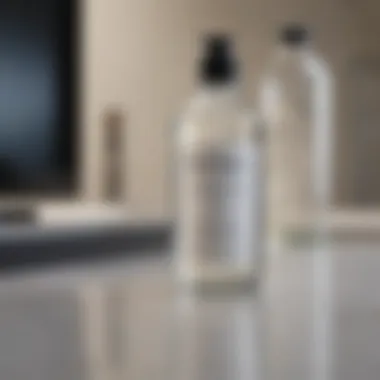Expert Tips for Cleaning Your High-Definition TV Screen Safely and Effectively


This article offers an in-depth insight into the best methods for effectively cleaning an HD TV screen. By following the recommendations provided here, you can ensure the clarity and durability of your TV screen without causing any harm.
To begin the cleaning process, it is essential to gather the necessary materials. You will need a microfiber cloth, distilled water, and isopropyl alcohol. These items are gentle on the screen and help in removing dust and smudges without damaging the delicate surface.
Before starting the cleaning procedure, ensure that the TV is turned off and has cooled down to prevent any potential heat damage. Gently wipe the screen with the dry microfiber cloth to eliminate loose particles and dust.
Next, dampen a corner of the microfiber cloth with distilled water. Avoid spraying liquid directly on the screen to prevent water seepage into internal components. Make sure the cloth is slightly moist, not dripping wet, to clean the screen effectively.
If there are stubborn smudges or marks on the screen, dampen another corner of the microfiber cloth with isopropyl alcohol. This helps in cutting through grease and fingerprints, leaving the screen spotless.
Once you have wiped the entire screen with the damp cloth, use a dry part of the cloth to remove any residual moisture and ensure a streak-free finish. Allow the screen to air dry completely before turning the TV back on.
By following these meticulous steps and using the right cleaning materials, you can maintain the pristine condition of your HD TV screen and enjoy a crystal-clear viewing experience every time.
Introduction
Cleaning an HD TV screen is a task that requires precision and attention to detail to maintain its clarity and prolong its lifespan effectively. A comprehensive understanding of the proper cleaning methods and materials is essential in ensuring the best care for your valuable television investment.
Understanding the Importance of Proper Cleaning
Preventing Image Quality Degradation
Proper cleaning of an HD TV screen is crucial for preventing image quality degradation. Dust, smudges, and dirt buildup can significantly impact the viewing experience by reducing the clarity and sharpness of the screen. By adopting the correct cleaning practices, you can preserve the pristine quality of your TV screen and enjoy optimal visual performance. Implementing regular cleaning routines helps in maintaining a spotless screen, free from distracting imperfections.


Common Mistakes to Avoid
Using Harsh Chemicals
One common mistake to avoid when cleaning your HD TV screen is using harsh chemicals. Chemical cleaners containing strong solvents or ammonia can damage the delicate screen surface, leading to discoloration or etching. Opting for gentle cleansers specifically designed for electronic screens ensures safe and effective cleaning without risking damage.
Using Abrasive Materials
Another error to steer clear of is using abrasive materials on the TV screen. Rough cloths, paper towels, or scrubbing sponges can scratch the screen or leave behind fine abrasions, compromising the display quality. Employing soft, non-abrasive microfiber cloths mitigates the risk of surface scratches and maintains the screen's smoothness.
Materials Needed for Cleaning
Microfiber Cloth
A microfiber cloth is a essential cleaning tool for an HD TV screen. The ultra-fine fibers of a microfiber cloth effectively capture dust particles and fingerprints without leaving lint or streaks behind. This lint-free cleaning action ensures a thorough and gentle cleaning process, safeguarding the screen's integrity.
Distilled Water
Distilled water is a recommended cleaning fluid for removing stubborn smudges and marks from the TV screen. Unlike tap water, distilled water is free from impurities and minerals that may leave residues on the screen when dry. Dampening the microfiber cloth with distilled water helps in achieving a streak-free and crystal-clear screen surface.
White Vinegar (Optional)
White vinegar serves as an optional cleaning agent for tougher stains or greasy spots on the TV screen. When diluted with distilled water, white vinegar acts as a natural degreaser that breaks down oil-based residues effectively. Its mild acidity aids in cutting through grime without causing any harm to the screen's display properties.


Methods for Cleaning
In this article, the methods for cleaning an HD TV screen are pivotal to maintaining its longevity and improving viewing experience. By carefully selecting appropriate cleaning techniques, users can ensure their screen remains free from dust, smudges, and other particles that can compromise image quality. These methods not only enhance screen clarity but also contribute to the overall care and maintenance of your valuable investment in electronic devices.
Dry Dusting the Screen
When it comes to dry dusting the screen, using a soft microfiber cloth is essential. This specific method allows for gentle removal of surface dust without scratching or damaging the screen. The key characteristic of a soft microfiber cloth lies in its ability to attract and trap dust particles effectively, leaving the screen clean and lint-free. Opting for a soft microfiber cloth minimizes the risk of static discharge commonly associated with alternative cleaning materials, ensuring a safe and thorough cleaning process.
Cleaning with Distilled Water
Incorporating distilled water into the cleaning process is a crucial step in maintaining screen cleanliness. Properly dampening the cloth with distilled water facilitates the removal of stubborn smudges and marks without leaving streaks or residue on the screen. The key characteristic of dampening the cloth adequately lies in achieving the right level of moisture to effectively lift dirt and grime off the screen surface without causing water damage. Additionally, gently wiping the screen with a damp cloth ensures thorough and precise cleaning, enhancing the visual quality of the display while prolonging the lifespan of the device.
Using White Vinegar Solution
Utilizing a white vinegar solution can offer a deeper level of cleaning for your HD TV screen. Mixing vinegar and water creates a gentle yet effective solution for tackling tough stains and greasy residues. The key characteristic of this solution lies in its natural acidity, which helps break down dirt and grease without harming the screen's delicate surface. Incorporating the white vinegar solution into your cleaning routine can provide an eco-friendly and affordable alternative to commercial cleaning products, promoting both screen clarity and environmental sustainability.
Additional Tips
Keeping the screen of your HD TV clean is essential for optimal viewing experience and longevity of your device. In this section, we will delve into additional tips that can further enhance the maintenance of your TV screen. These tips go beyond regular cleaning methods and offer extra measures to ensure your screen remains pristine for a long time. By incorporating these additional tips into your cleaning routine, you can elevate the overall quality of your viewing sessions and protect your investment in a high-definition TV. Let's explore these tips in detail.
Frequency of Cleaning
Establishing a Cleaning Routine


Establishing a regular cleaning schedule is a fundamental aspect of maintaining the cleanliness of your HD TV screen. A cleaning routine ensures that dust and dirt particles don't accumulate over time, affecting the visual clarity of your screen. By setting specific intervals for cleaning, you can stay proactive in preventing build-up and preserve the pristine appearance of your TV screen. Consistency is key when it comes to establishing a cleaning routine, as it allows you to address minor smudges and marks before they become more challenging to remove. Embracing a cleaning routine as part of your television care regimen is a proactive approach to keeping your screen in optimal condition, prolonging its lifespan and ensuring uninterrupted viewing pleasure.
Protective Measures
Using Screen Protectors
Adding a screen protector to your HD TV screen can offer an additional layer of defense against scratches, fingerprints, and dust. This protective measure not only safeguards the screen surface but also simplifies the cleaning process by providing a smooth and easily wipeable surface. Screen protectors come in various sizes and can be custom-cut to fit your specific television model, ensuring a perfect fit. By applying a screen protector, you create a barrier between the screen and external elements, minimizing the risk of damage and reducing the frequency of intense cleaning sessions. Additionally, screen protectors are often anti-reflective, improving your viewing experience by reducing glare and enhancing screen visibility.
Avoiding Direct Sunlight
Minimizing Glare and Heat Exposure
Direct sunlight can have detrimental effects on your HD TV screen, including glare and potential heat damage. To mitigate these risks, it is crucial to position your television away from direct sunlight sources to prevent glare that can hinder viewing quality. Minimizing heat exposure is equally important, as prolonged sunlight exposure can impact the screen's performance and longevity. By strategically placing your TV in a shaded area or using curtains or blinds to regulate light exposure, you can maintain optimal viewing conditions and protect your screen from unnecessary strain. Avoiding direct sunlight not only enhances your viewing experience but also contributes to the long-term health of your HD TV screen.
Conclusion
In the realm of maintaining a pristine HD TV screen, the conclusion serves as a pivotal guidepost towards achieving top-tier viewing experiences. Emphasizing the importance of consistent upkeep, this section encapsulates the essence of safeguarding your investment in modern entertainment technology. By adhering to the insights shared throughout this guide, viewers can bask in the brilliance of crystal-clear displays and extended durability.
Maintaining Screen Clarity
Following Best Practices
When it comes to maintaining screen clarity, following best practices stands out as a beacon of wisdom in the sea of screen-cleaning techniques. This meticulous approach ensures that every swipe of the cleaning cloth leads to a gleaming surface free from distracting smudges and blemishes. The key characteristic of following best practices lies in its focus on gentle yet thorough cleaning methods, avoiding harsh chemicals or abrasive materials that could compromise the screen's integrity. This prudent choice fosters a nurturing environment for the screen, enhancing its longevity while preserving its visual acuity. The unique feature of following best practices is its holistic approach, which not only addresses immediate cleaning needs but also promotes long-term health for the TV screen, making it a preferred choice for those seeking sustained viewing quality.
Ensuring Longevity
Preserving the Quality of Your HD TV Screen
Safeguarding the quality of your HD TV screen is paramount for ensuring its longevity and optimal performance. By focusing on preservation techniques, users can fortify their screens against potential wear and tear, thus extending the lifespan of their beloved devices. The key characteristic of preserving the quality of your HD TV screen revolves around meticulous attention to detail and a commitment to proactive maintenance. This approach acts as a shield against environmental factors and daily usage, maintaining the screen's brilliance over time. The unique feature of this preservation method lies in its ability to create a tailored care routine for each screen, considering factors like screen type, usage patterns, and environmental conditions. While demanding a bit more effort, the advantages of preserving screen quality far outweigh the minor inconveniences, ensuring that your viewing experience remains unparalleled for years to come.



